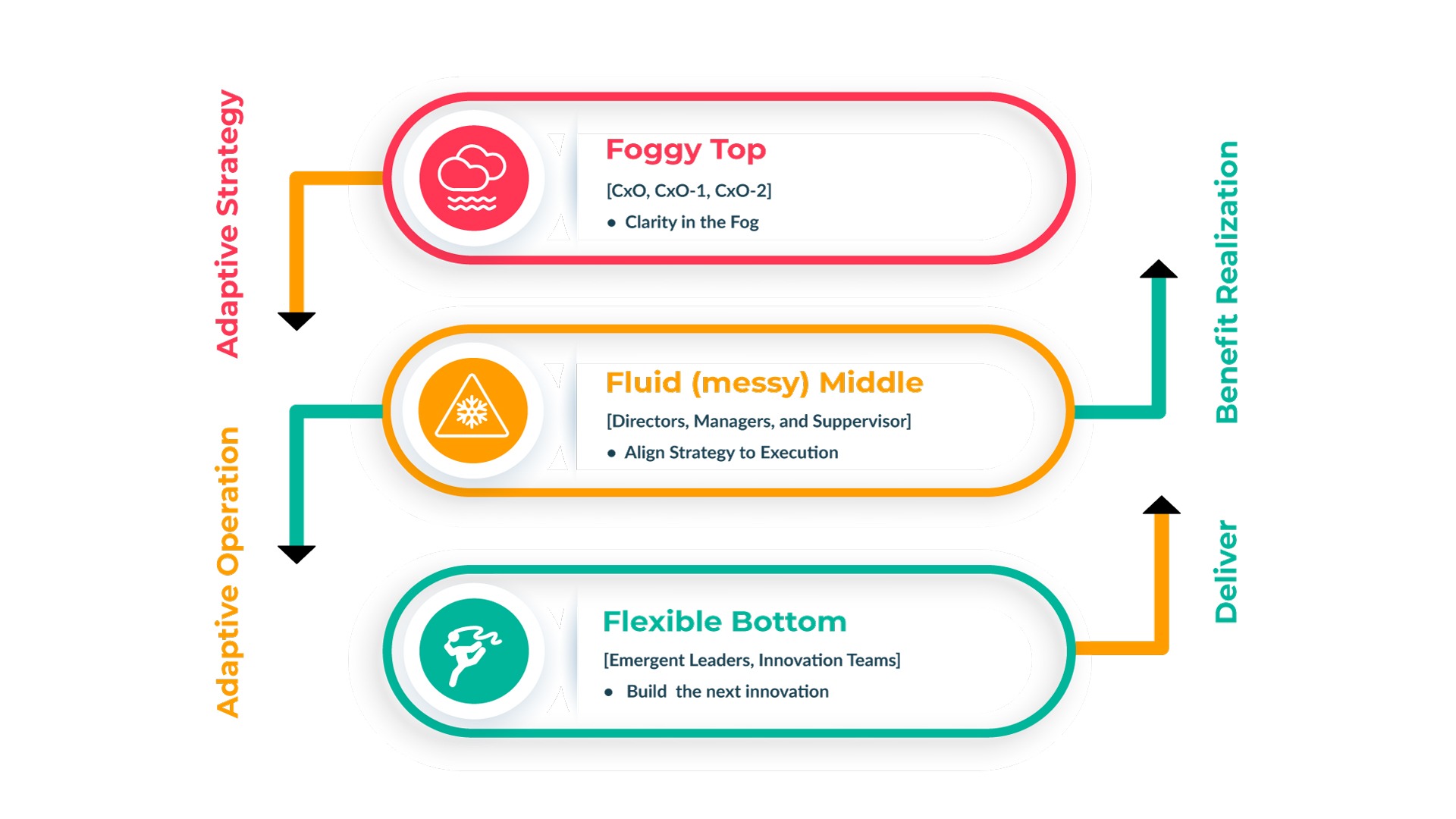E120: Navigating Three Layers of Leadership: Foggy Top, Fluid Middle, and Flexible Bottom

Generative Leadership Harmonizes The Three Organization layers
In most organization designs, the business ecosystem consists of three layers of leadership working to deliver value in an uncertain environment while maintaining continuity to run and grow the business. Leaders at each layer experience different challenges and successes as they shift toward adaptive strategy and operations to deliver value and achieve benefit realization (the promise). The relationship between each layer requires communicating regularly, sharing information, and collaborating on solutions. The key to a harmonious experience is that leaders must respect each other's roles and responsibilities.
Generative leadership creates an environment that nurtures innovation, growth, and adaptability. This leadership practice allows each layer to support business continuity to run and grow the business. A compelling story of generative leadership often involves one or more leaders to foster a culture where team members feel empowered to generate new ideas, take risks, and learn from failures.
Leadership Layers Successes and Challenges
| Layer | Successes | Challenges |
| Foggy Top | People experience greater clarity and understanding of the environment, a shared vision and strategy, and stronger stakeholder relationships. | Communicating their vision clearly and concisely. Once leaders at this level have a clear understanding of the situation, they need to be able to share their vision with others in an inspiring and actionable way. |
| Fluid / Messy Middle | More effectively aligning strategy to execution, reduced resistance to change, higher team morale and engagement. | Building and maintaining team morale. Leading in a complex and changing environment can be stressful and demanding. Leaders at this layer must support their teams and help them stay motivated and engaged. |
| Flexible Bottom | Increased innovation and agility, a faster time to market for new products and services, and a more engaged and empowered workforce. | Delivering value in a rapidly changing environment. This can be challenging, as customers' needs and expectations constantly evolve. Leaders at this layer need to be able to be innovative and adaptable. They also need to be able to work quickly and efficiently to bring new products or services to market. |
The Story of InterAI
InterAI, led by a savvy and experienced CxO team, established itself as a pioneer in artificial intelligence with a reputation for innovation and cutting-edge technology. However, beneath the surface of success, InterAI faced a challenge that threatened to stifle its growth and creativity. The company's Fluid/Messy Middle, comprising directors, managers, and supervisors, had become entrenched in their ways, resistant to change, and unwilling to embrace new ideas. This resistance created a disconnect between the Foggy Top, the CxO team, who were brimming with visionary ideas, and the Flexible Bottom, the emergent leaders and innovation teams, who were eager to experiment and push boundaries.
Recognizing the need to bridge this gap and foster a culture of generative leadership, the CxO team embarked on a bold initiative. They initiated a series of workshops and training sessions designed to equip the Fluid/Messy Middle with the skills and mindset necessary to embrace innovation and change. They emphasized empowering employees, encouraging risk-taking, and fostering a collaborative environment.
Meanwhile, the Flexible Bottom, energized by the CxO's initiative, developed new ideas and experimented with new technologies. They formed cross-functional teams, breaking down silos and fostering collaboration between different departments. They embraced failure as an opportunity for learning and growth, creating a safe space for experimentation and innovation.
As the CxO team's efforts began to take root, the Fluid/Messy Middle started to thaw. Managers and directors began to embrace change, encouraging their teams to take risks and experiment with new ideas. They started to see the value in empowering employees and giving them the freedom to innovate.
The Flexible Bottom, empowered by the support of the Fluid/Messy Middle, continued to push the boundaries of innovation. They developed groundbreaking AI solutions that were revolutionizing the industry. Their work was gaining recognition within the company and beyond, attracting the attention of potential partners and investors.
InterAI's transformation was remarkable. The company was no longer constrained by the limitations of its Fluid/Messy Middle. Instead, the company thrived on the collective energy and creativity of its entire workforce, from the CxO team at the top to the emergent leaders and innovation teams at the bottom.
InterAI's story is a testament to the power of generative leadership. When all levels of an organization are aligned and empowered, there is no limit to what can be achieved.
Conclusion
By successfully shifting toward more adaptive and flexible strategies and operations, organizations can realize benefits such as increased responsiveness to market changes, improved employee engagement, faster innovation cycles, and, ultimately, more robust financial performance and market positioning.
Podcast (ks_dd): Play in new window | Download (Duration: 7:40 — 14.0MB) | Embed
Subscribe: Apple Podcasts | Email | RSS
